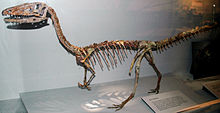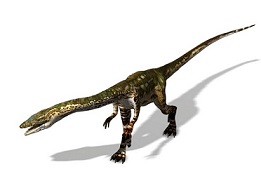
Podokesaurus is a lesser-known yet intriguing dinosaur that prowled the Earth during the Early Jurassic period, approximately 200 million years ago. This dinosaur belongs to the theropod group, a lineage known for its bipedal stance and carnivorous diet. Despite its modest size, Podokesaurus is a valuable piece in the puzzle of prehistoric life, offering insights into the diversity and adaptations of early Jurassic dinosaurs.
Podokesaurus was first discovered in the early 20th century in North America, specifically in the states of Massachusetts and Connecticut. Its name means swift-footed lizard, reflecting its presumed agility. Over time, several specimens have been attributed to this genus, although it remains relatively obscure compared to other theropods like Tyrannosaurus rex or Velociraptor.
| Name: | Podokesaurus dinosaurs |
| Size: | Around 6-7 feet in length. |
| Main Facts: | Podokesaurus is a small, carnivorous theropod from the Early Jurassic, offering insights into the diversity of predatory dinosaurs during this period.. |
Despite its small stature, Podokesaurus possessed typical theropod characteristics. It had a bipedal stance, sharp teeth, and sharp claws on its hands. These features were adaptations for its carnivorous lifestyle, suggesting it was an agile and efficient predator.

The teeth of Podokesaurus were serrated, indicating that it had a carnivorous diet. It likely preyed on small animals such as insects, small reptiles, or early mammals that populated the Jurassic landscape.
Podokesaurus lived during the Early Jurassic, a time when dinosaurs were still diversifying and evolving. The environment was lush and teeming with various types of flora and fauna, providing a rich setting for this small predator.
Fossils of Podokesaurus have primarily been found in North America, specifically in the eastern United States. This distribution highlights the varied ecosystems and habitats that existed on the continent during the Early Jurassic.
Despite its relatively limited recognition, Podokesaurus is valuable for paleontologists because it offers a glimpse into the early stages of theropod evolution. It lived in an era when many theropod lineages were emerging, some of which would later give rise to iconic predators like Allosaurus and Tyrannosaurus rex.
Podokesaurus, a small theropod from the Early Jurassic, measured around 6-7 feet in length and stood about 3 feet tall at the hip. Its sharp teeth and claws, characteristic of theropods, indicate a carnivorous diet, likely preying on small animals and early mammals. Fossils of Podokesaurus have been primarily found in the eastern United States.
It inhabited an environment rich in diverse flora and fauna during a time when dinosaurs were diversifying. Though modest in size, Podokesaurus represents an important piece in understanding the early stages of theropod evolution and the intricate ecosystems of the Early Jurassic period.
Podokesaurus, a relatively small theropod at around 6-7 feet, contrasts with larger predators like Allosaurus and Tyrannosaurus rex, showcasing the range of body sizes in theropods.
Like many theropods, Podokesaurus had sharp teeth and claws for hunting and a carnivorous diet. This common dietary trait connects it to other meat-eating dinosaurs.
Podokesaurus, like most theropods, walked on two legs. This bipedal adaptation is seen in various theropod lineages, from small predators to massive ones.
Podokesaurus inhabited the Early Jurassic period, a time when dinosaurs were diversifying. Comparisons with later theropods provide insights into evolutionary trends within this group..
Fossils of Podokesaurus have been found in eastern North America, highlighting regional variations in theropod habitats and ecosystems.
Podokesaurus had serrated teeth adapted for slicing through flesh, a feature it shares with other carnivorous dinosaurs, allowing efficient hunting and feeding.
Comparing Podokesaurus to other theropods reveals different strategies and adaptations for predation, from the swift and agile nature of small predators to the sheer power of large ones.
Podokesaurus offers insights into the early stages of theropod evolution, showing that small, agile predators were already present in the Early Jurassic.